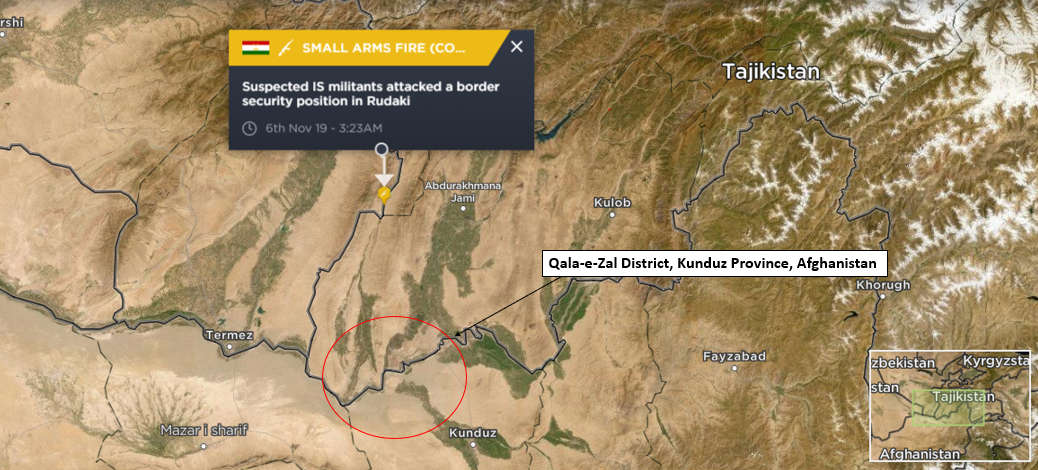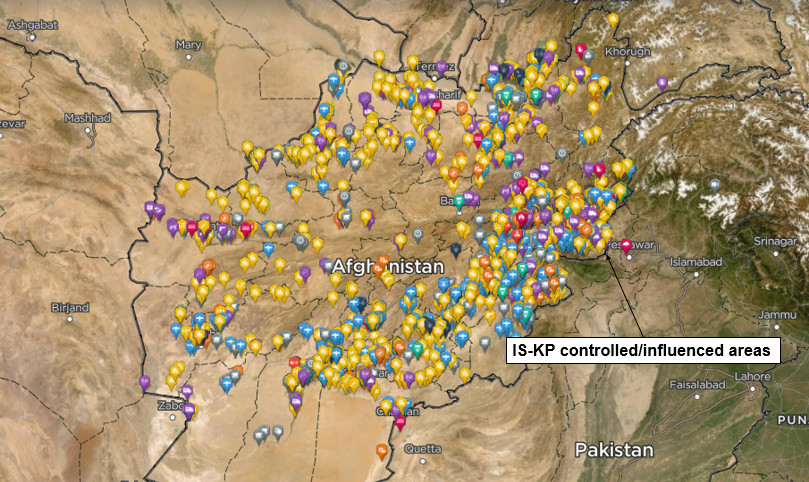Analysing the Islamic State Attack on Tajikistan
On the 6th November, Tajik authorities claimed that a group of 20 Islamic State militants attacked a checkpoint on the Tajikistan-Uzbekistan border in the Ishkebod area of Rudaki.
According to the official statement regarding the incident released by the Tajik government, 15 of the attackers were killed and five others were captured at the scene however, the Tajik MoI claimed that just four were arrested. Five assault rifles were also recovered.
In the exchange of fire, a border guard and a police officer were also killed. The attackers allegedly entered Tajikistan on the 3rd November from Afghanistan into the Qabodiyon district and arrived at the checkpoint in four Tajik-registered vehicles, all of which were destroyed in the incident.

Image shows location of incident and the Qala-e-Zal district, where the militants allegedly entered Tajikistan on the 3rd November. Source: Intelligence Fusion 2.0.
On the 7th November, IS released a video showing six fighters pledging allegiance to the new leader of Islamic State Abu Ibrahim al-Hashemi al-Quraishi, and simultaneously claimed responsibility for the attack. Since the attack, authorities have released the names of the five suspects arrested at the scene, with all of the five of the suspects allegedly coming from Istravshan, Tajikistan. According to a RFE/RL report, the mayor of the village where two of the suspects were from claimed that the suspects left the village in 2014, although the suspect’s whereabouts after 2014 are unclear.
Islamic terrorism in Tajikistan and surrounding Central Asian states is a recurring theme, with fighters from across the region active with the Islamic State in Afghanistan and the Middle East. With large numbers of Central Asian militants active in places such as Syria and Iraq, governments have understandably raised fears over the threat posed by these militants once they return to their home countries.
Islamic State are not the only Islamic group seen to pose a threat to Tajikistan, as despite the largely secular governments of the region, a variety of groups have flourished. In a document released by the Tajik Government shortly after the 6th November attack, titled ‘The Manifestations of Extremism and its Negative Consequences,’ Hizb ut-Tahrir, Jamaat Ansarullah, Bay’at and the Islamic Movement of Uzbekistan are all highlighted as threats to the state. The same document goes on to claim that approximately 300 Tajik nationals are currently fighting in Syria.
Despite large numbers of fighters travelling abroad to fight, actual Islamic State attacks in Tajikistan itself are rare. The most recent IS-related incidents were a mass prison riot at a facility in Vahdat in May 2019, and an attack on a group of US tourists in July 2018. Neither attack involved large numbers of militants with small arms. Even when Islamic State – Khorosan Province (IS-KP) held territory in the north of Afghanistan, close to the Tajik border, no increase in attacks was recorded.
Details regarding the attack were released uncharacteristically fast, with both images and a narrative released. The images released show the four vehicles almost totally burnt out, with charred bodies surrounding them. In the corner of one of the photos, one of the bodies can be seen with their hands bound, although details over this specific belligerent’s death are unclear.
Doubts over the validity of the Tajik government’s version of events were raised immediately after the incident. For example, whilst the Tajik Government explained that the militants are believed to have been from Tajikistan itself, it’s not clear if the militants were active fighters in Afghanistan or if they were only in Afghanistan on a short-term basis.
Furthermore, if the militants were active in Afghanistan, it’s unclear if they were based in the Taliban-dominated north of the country, or if they’d travelled from IS-KP influenced areas in the east of Afghanistan. If such a large group was based in the north, this would potentially represent a stronger IS presence in the north of the country than is widely assumed. If the militants were from the IS controlled areas in the east of the country, the journey north to Tajikistan presents problems in its own way. Such a journey would not only be long, but would mean travelling through areas where Taliban fighters are prevalent, and outsiders are expected to stand out.

Image shows locations of significant incidents recorded in Afghanistan in 2019 to date (November 10th, 2019.) The northern provinces of Afghanistan record high levels of instability and violence, however, IS-KP influence is largely limited to the East. Source: Intelligence Fusion 2.0.
Secondly, the period of time spent in Tajikistan and the route taken from the southern border to Ishakbod, where the attack took place, raises additional questions. Analysts immediately queried how the group travelled from the southern border to Ishkabod without being detected at other checkpoints along the route.
Whilst the Afghan Government denied that the fighters came from Afghanistan, a New York Times article cited the Qala-e-Zal district governor (the district where Tajikistan claims the militants crossed the border) as saying that an IS commander had arrived in the district to carry out recruitment shortly before the attack. The details from the attack itself also raised questions. For example, unless the attack was botched in some form, it’s difficult to comprehend how only 2 members of security forces were killed when faced with such a large force.
Also, after a sweep of the scene after the shootout, security forces claimed to have seized just five firearms from a group of 20. One would expect such a large group to be better prepared for such an attack. Until further reliable details are released, answers to the previous queries are limited to mere speculation. However, it should be noted that in the video released by IS claiming to show the attackers, only six fighters featured, raising additional questions as to the identity of the other fighters involved.
Islamic State has not attempted to hide its intentions to carry out attacks in Central Asia, as much of the region is contained in ‘Khorosan Province’ which the group’s Afghan affiliate claims to encompass. However, the actual threat posed to Central Asia by IS in Afghanistan is considered to be over-exaggerated. IS in Afghanistan is dominated by local concerns within Afghanistan, and with its territorial control being in the east of Afghanistan on the Pakistani border, the group is also geographically dislocated form Central Asia.
Nevertheless, IS presence in Afghanistan can still be seen as a threat, albeit in a more limited capacity then Central Asian states claim. Not only because small cells of IS-KP militants can enter Central Asia from Afghanistan, but also because multiple Central Asian militants have fought in Afghanistan, gaining experience and connections, before returning to their home countries.
The only formal data released regarding the incident has come directly from the Tajik Government, with claims regarding the incident also released by Islamic State itself. Without further releases of data, the narratives put forward will remain unconfirmed, as neither source is considered consistently reliable. Regardless, the incident highlights the potential global reach of Islamic State in Central Asia, where extremist groups have found fertile recruitment grounds.
An incident report from Intelligence Fusion’s threat intelligence platform provides clients with the complete picture. We follow each incident until they’ve concluded, adding new details and intelligence as we uncover them. This includes adding context in the form of multiple narratives surrounding an incident such as the Islamic State attack on a Tajikistan security checkpoint.
IF’s analysts add various accounts as well as they’re assessment as to which they believe is most likely, where appropriate.
Do you get this level of details from your intelligence provider?
References
https://www.ozodi.org/a/identity-of-five-alleged-militants-attacked-sultanabad-outpost/30259305.html
https://www.nytimes.com/2019/11/06/world/asia/isis-tajikistan.html
